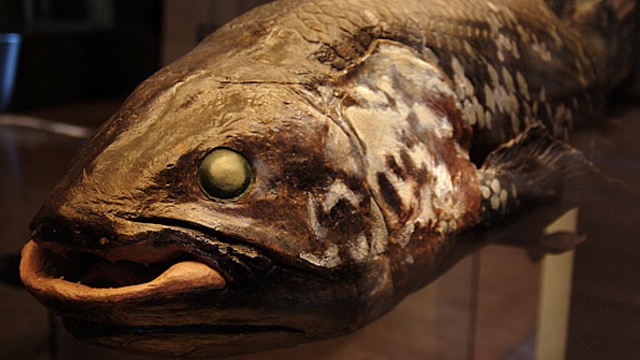SUMMARY
This is AI generated summarization, which may have errors. For context, always refer to the full article.

PARIS, France – Biologists on Wednesday, April 17, said they had unravelled the DNA of the coelacanth, a “living fossil” fish whose ancient lineage can shed light on how life in the sea crept onto land hundreds of millions of years ago.
Analysis of the coelacanth genome shows three billion “letters” of DNA code, making it roughly the same size as a human’s, they said.
The genetic blueprint appears to have changed astonishingly little over the aeons, pointing to one of the most successful species ever investigated.
“We found that the genes overall are evolving significantly slower than in every other fish and land vertebrate that we looked at,” said Jessica Alfoeldi of the Broad Institute of the Massachusetts Institute of Technology and Harvard.
Found in deep waters off South Africa, with cousins off the coast of Indonesia, coelacanths are one of the oldest species that exist today. The grey-brown fish can grow up to two meters (6.5 feet) in length and weigh as much as 91 kilos (200 pounds).
A fossilized skull described by Chinese paleontologists dates the first coelacanth to 375 million years ago.
One of the big interests in coelacanths is in their lobe-shaped fins.
These have sparked speculation that coelacanths were part of a group of fishes that used stubby appendages to ease their way out of water and eventually crawl onto land.
There, bit by bit, they evolved into four-legged animals called tetrapods.
The new study says a closer living relative to the tetrapods than the coelacanth is a freshwater fish found in Australia and Africa called the lungfish.
Even so, the coelacanth is a remarkable source, for it will help show which genes were squeezed out, and which emerged, in the touted sea-to-land transition.
Among the changes are how the new-found landlubbers developed a sense of smell to detect airborne molecules pointing to threat or food — and how their immune system changed in response to bacteria and viruses in a new environment.
Coelacanths were thought to have died out around 65 million years ago, roughly at the same time as the dinosaurs.
That changed when one was caught off South Africa in 1938, a landmark event in zoology.
The species was given the Latin honorific Latimeria chalumnae, after Marjorie Courtenay-Latimer, curator of a small natural history museum in East London, South Africa, who identified an unusual fish given to her by a local trawlerman.
Since then, only 308 other coelacanths have ever been recorded.
The species’ success story is due to their ability to exploit a stable niche in the world’s habitat.
“We often talk about how species have changed over time,” said fellow researcher Kerstin Lindblad-Toh.
“But there are still a few places on Earth where organisms don’t have to change, and this one of them. Coelacanths are likely very specialized to such a specific, non-changing extreme environment — it is ideally suited to the deep sea just the way it is.”
The study appears in the British science journal Nature. – Rappler.com
Add a comment
How does this make you feel?
There are no comments yet. Add your comment to start the conversation.